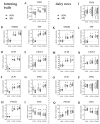Antioxidant and Inflammatory Gene Expression Profiles of Bovine Peripheral Blood Mononuclear Cells in Response to Arthrospira platensis before and after LPS Challenge
- PMID: 34065248
- PMCID: PMC8161185
- DOI: 10.3390/antiox10050814
Antioxidant and Inflammatory Gene Expression Profiles of Bovine Peripheral Blood Mononuclear Cells in Response to Arthrospira platensis before and after LPS Challenge
Abstract
Oxidative stress and inflammatory diseases are closely related processes that need to be controlled to ensure the desirable high performance of livestock. The microalga spirulina has shown antioxidant and anti-inflammatory properties in monogastric species. To investigate potential beneficial effects in ruminants, we replaced soybean meal (SOY) in the diets of dairy cows and fattening bulls by spirulina (SPI) and analyzed plasma concentrations of antioxidants (β-carotene, α-tocopherol, polyphenols) and serum total antioxidant capacity. Following in vitro stimulation with lipopolysaccharide (LPS), peripheral blood mononuclear cells (PBMCs) were isolated for expression analysis of inflammation- and antioxidant-defense-related genes. Plasma β-carotene concentration was higher in SPI, compared to SOY cows, but did not differ in bulls. Plasma total phenol concentration was significantly higher in SPI, compared to SOY bulls, but not in cows. Stimulation of bovine PBMCs with LPS increased the expression of most cytokines and some antioxidant enzymes. Gene expression of PBMCs derived from SPI animals, compared to SOY animals, hardly differed. Our results indicate that in ruminants, spirulina might not have potent antioxidant and anti-inflammatory properties. Future studies should evaluate the microbial degradation of spirulina and its bioactive compounds in the rumen to provide further data on potential beneficial health effects in ruminants.
Keywords: dairy cows; fattening bulls; inflammation; leukocytes; lipopolysaccharide; microalgae; spirulina.
Conflict of interest statement
The authors declare no conflict of interest.
Figures



Similar articles
-
Effects of the substitution of soybean meal by spirulina in a hay-based diet for dairy cows on milk composition and sensory perception.J Dairy Sci. 2020 Dec;103(12):11349-11362. doi: 10.3168/jds.2020-18602. Epub 2020 Oct 9. J Dairy Sci. 2020. PMID: 33041025
-
The effect of partial substitution of rapeseed meal and faba beans by Spirulina platensis microalgae on milk production, nitrogen utilization, and amino acid metabolism of lactating dairy cows.J Dairy Sci. 2019 Aug;102(8):7102-7117. doi: 10.3168/jds.2018-16213. Epub 2019 May 31. J Dairy Sci. 2019. PMID: 31155260
-
The effect of Spirulina platensis meal on antioxidant gene expression, total antioxidant capacity, and lipid peroxidation of rainbow trout (Oncorhynchus mykiss).Fish Physiol Biochem. 2019 Jun;45(3):977-986. doi: 10.1007/s10695-019-0608-3. Epub 2019 Jan 16. Fish Physiol Biochem. 2019. PMID: 30648194
-
The antioxidant, immunomodulatory, and anti-inflammatory activities of Spirulina: an overview.Arch Toxicol. 2016 Aug;90(8):1817-40. doi: 10.1007/s00204-016-1744-5. Epub 2016 Jun 3. Arch Toxicol. 2016. PMID: 27259333 Review.
-
Antioxidant, Immunomodulating, and Microbial-Modulating Activities of the Sustainable and Ecofriendly Spirulina.Oxid Med Cell Longev. 2017;2017:3247528. doi: 10.1155/2017/3247528. Epub 2017 Jan 15. Oxid Med Cell Longev. 2017. PMID: 28182098 Free PMC article. Review.
Cited by
-
Effect of Spirulina Dietary Supplementation in Modifying the Rumen Microbiota of Ewes.Animals (Basel). 2023 Feb 19;13(4):740. doi: 10.3390/ani13040740. Animals (Basel). 2023. PMID: 36830527 Free PMC article.
-
Exploring Black Soybean Extract Cream for Inflammatory Dermatitis-Toward Radiation Dermatitis Relief.Int J Mol Sci. 2024 Oct 29;25(21):11598. doi: 10.3390/ijms252111598. Int J Mol Sci. 2024. PMID: 39519149 Free PMC article.
References
-
- United States Department of Agriculture . Part III: Health Management and Biosecurity in U.S. Feedlots, 1999. USDA, APHIS, VS, CEAH, National Animal Health Monitoring System; Fort Collins, CO, USA: 2000. #N336.1200.
-
- Sies H. Biochemistry of Oxidative Stress. Angew. Chem. Int. Ed. Engl. 1986;25:1058–1071. doi: 10.1002/anie.198610581. - DOI
Grants and funding
LinkOut - more resources
Full Text Sources

